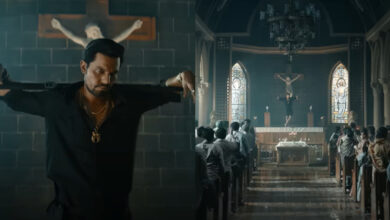Why Rishi Kapoor and Paresh Rawal’s scenes in Sharmaji Namkeen aren’t separated chronologically

Rishi Kapoor’s final film, Sharmaji Namkeen, was released on Amazon Prime Video earlier this month to positive reviews. Directed Hitesh Bhatia, the film was completed after Kapoor’s death midway through production. Actor Paresh Rawal stepped in to help finish the remaining scenes, in a rare situation where two actors are playing the same character, without any on-screen acknowledgement.
Sharmaji Namkeen tells the story of a recently retired widower, who begins moonlighting as a cook at private parties to keep himself occupied, much to the disapproval of his elder son. While Sharmaji goes about his secret life, he realises that his son is also keeping things from him. Their strained relationship, and their desire to mend it, forms the emotional core of the film.
Some viewers who tuned in to the film were surprised to learn that Kapoor and Rawal step in and out of the film randomly. Sometimes, this happens in the same scene. While more seasoned audiences would know that films aren’t shot chronologically, for casual viewers, the unconventional situation served as an insight into the logics of making movies.
What happened
Kapoor, one of Hindi films’ most resilient stars, died after a two-year battle with cancer in April 2020. This was during the first lockdown, when all film shoots had been indefinitely suspended. Kapoor had already commenced work on Sharmaji Namkeen, but his cancer had returned after he signed on.
What alternatives were considered
Kapoor’s son, actor Ranbir Kapoor, said that having him play the lead character, (under prosthetics, of course) was considered at one point. But the plan was axed for several reasons, one of which, Ranbir said, was that he simply isn’t old enough to play a retiree.
Producer Farhan Akhtar assured audiences that they would leave no stone unturned in completing the film after Kapoor’s death, and said that they were contemplating CGI techniques.
Ultimately, Rawal was brought in to play the role. This was perhaps the most cost-effective route that the filmmakers could have taken.
Why aren’t films shot chronologically?
Movies are almost always shot out-of-order. The boring answer is that shooting chronologically can significantly add to the budget. This can happen because of logical reasons, such as the availability of actors and certain locations, or perhaps because the indoor and outdoor shooting schedules are usually bifurcated. It should also be noted that not all scenes involve actors; some of these scenes are overseen a second unit, or a third unit. Action, for instance, usually requires a separate shooting schedule. Rarely are these decisions creatively motivated, except in some cases, which we’ll get to in a moment.
We must also remember that not all films tell their stories chronologically. Many, like Memento and Pulp Fiction, employ what can be described as a ‘non-linear’ narrative.
Has something like this been done before?
There have been several unfortunate instances of actors dying during production. Sometimes, this has happened very early in the process, like when Bruce Lee died after having shot only a fraction of his final film, Game of Death. The film was ‘completed’ using stand-ins. Conversely, his son Brandon Lee died with only a few days of shooting left for The Crow.
But perhaps the most notable case of different actors stepping in to help finish a partially shot movie is 2009’s The Imagination of Doctor Parnassus, which was originally supposed to star Heath Ledger in the lead role. But after Ledger’s death in 2008, his friends from the industry, Colin Farrell, Jude Law and Johnny Depp offered to help director Terry Gilliam complete the film. Gilliam revealed that many other actors had made similar offers–it was said that Tom Cruise wanted to contribute–but the filmmaker wanted to make sure that only Ledger’s actual friends should be involved in his final film.
Some movie are, in fact, shot chronologically
For creative reasons, a filmmaker might choose to shoot their film in order. Director Ron Howard wanted star Russell Crowe’s character to have a natural progression in A Beautiful Mind, which is why he shot 90% of the film chronologically. Steven Spielberg used a similar approach for ET the Extra-Terrestrial, mostly to help his young cast follow the thrust of the narrative. But these are luxuries that are rarely afforded to most directors.




